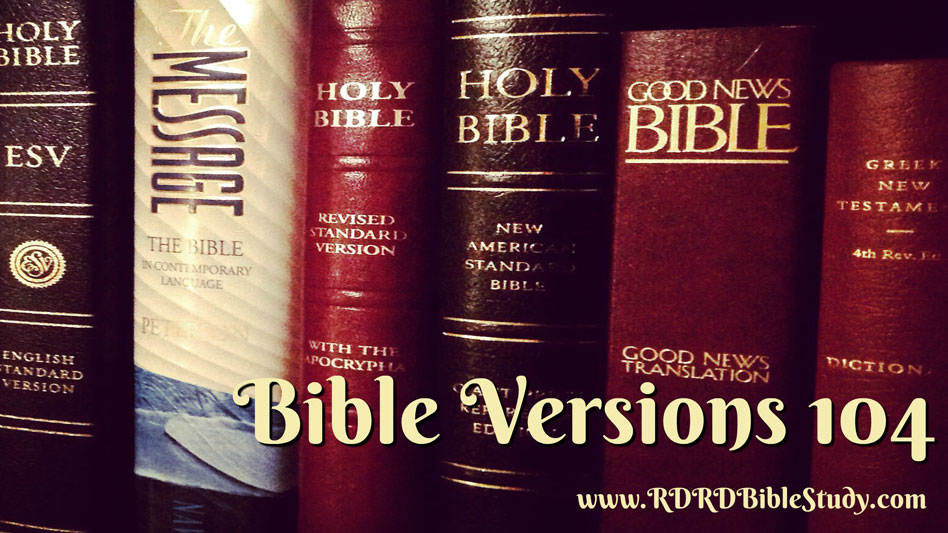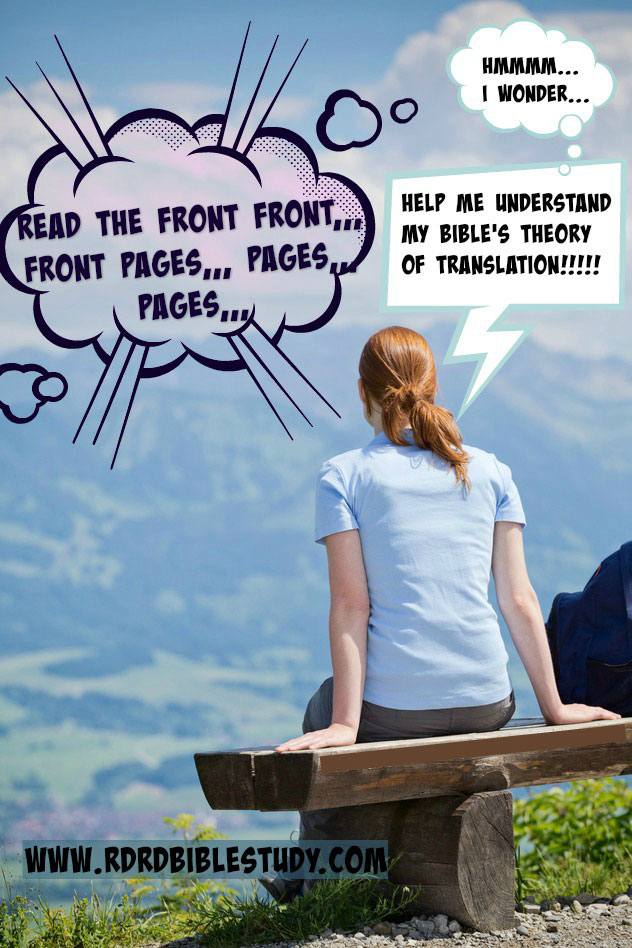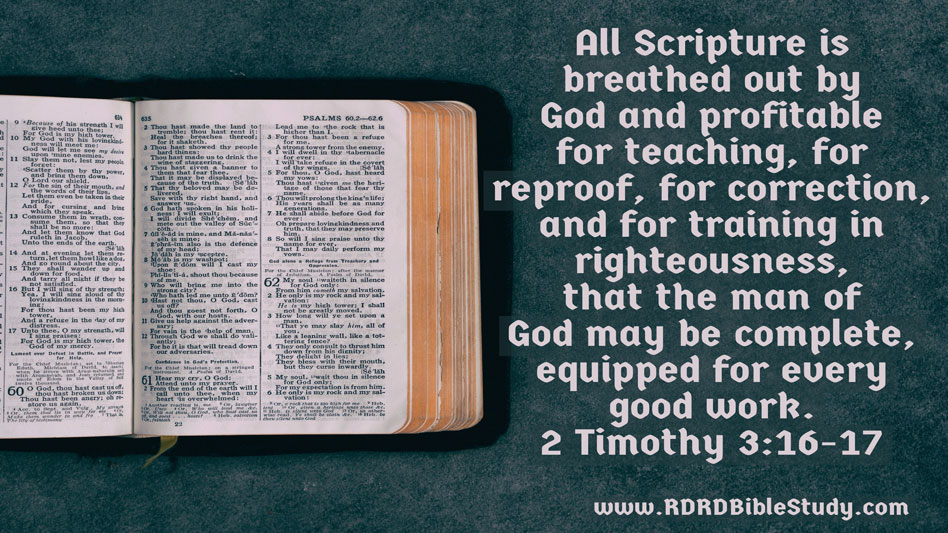Here it is! The final post of a four-post series on Bible Versions, aka Bible translations.
Posts so far in the series are:
Bible Versions 101: Translation and Interpretation discusses the difference between translation and interpretation.
Bible Versions 102, Textual Criticism discusses the original text.
Bible Versions 103: Linguistics discusses the language used in a Bible translation and the theory of translations.
And Bible Versions 104: Choosing a Translation takes on the practical—choosing a translation, or more likely, translations, to use.
Choosing A Translation
So why is a post about choosing a Bible translation, aka Bible version, necessary? Because choosing a Bible translation is a very important task. And because it’s a reminder that you need to choose Bible translations for two purposes:
- Main– a main Bible to use
- Study– the study Bible(s) to use
Bible Versions 103 made this point:
The best theory of translation is one that remains faithful to both the original and receptor languages. With the caveat that if something has to “give” it should be in favor of the receptor language [to language] without losing the meaning of the original language [from language]. After all, the purpose of a translation is so you and I can read it and hear what God is saying to us.
With that in mind…
Which Bible Translation(s) Should You Use?
Answer the following multiple choice question.
The primary reason for choosing a particular translation should be:
- “Because I like it”
- “It is readable”
- “My preacher says it is the one he/she uses”
- “Some blogger among the 2 zillion bloggers says to use this one”
- “None of the above”
If you chose #5, you are correct! Though #1 and #2 are sort of correct as a combined answer.
Choosing A Translation Based On An Informed Choice
The truth is that whatever version you choose, you really should like it. And it really should be readable. Most of all it should be one that you choose intentionally based on an informed choice.
And the choice is yours. You are equipped with the tools you need to make an informed decision. Already you know about:
- Interpretation and translation
- Textual criticism
- The science of translation
- Some specific details about theories of translations used by some English Bibles
Though you are familiar with these concepts you may still have questions about a certain translation. So what should you do? I am SO glad you asked!
Read A Bible’s Beginning Pages To Find Out All About Its Translation
Read its beginning pages—you know the part everyone skips. These pages are a literal wealth of information. The preface (or sometimes called introduction) will explain the translation’s particular theory of translation, including historical distance issues such as gender, money, weights, etc.
You will recognize many of the terms that have been used throughout the RDRD Bible Versions series.
Armed with the information needed, here are some helpful guidelines and things to think about when making choices about which Bible(s) to use.
Choose A Main Bible and Several Study Bible(s)
Your Main Bible
Choose a good translation to be used as your “main” Bible, i.e. the one you read daily, take to church, read first when beginning a study, etc. This helps both in memorization and in consistency. A good translation, for the most part, will translate words consistently.
We can agree that, based on the theory of translation, a functional equivalent version (NIV, ESV, NJB, NRSV, etc.) sounds like the best choice for a main Bible.
Formal equivalents, i.e. literal translations, in keeping close to historical distance, can contain some ambiguous phrases. Phrases that just aren’t used in English. Wording may be awkward, i.e. not readable.
And free translations can get too free. Free to the point of being a commentary on Scripture, yet not presented as a commentary.
Quick Note About The Message
Think about this: The Message is a widely popular and beloved free translation of Scripture. The Message was translated by Eugene Peterson, a formidable scholar. Peterson was the founding pastor of Christ Our King Presbyterian Church (PCUSA) in Maryland, where he served for 29 years.
The Message came about like this. Peterson questioned the church about the reason(s) for low attendance at Bible studies. Overwhelmingly the congregants complained about not being able to understand the Bible when they read it. So Peterson took Galatians and translated it into a “The Message” type of translation. The church people loved it! And they started asking him to do other books and Voila! The Message was born. (btw, I heard him tell this story during a lecture series at Beeson Divinity School.)
I don’t know with 100% accuracy, but I am fairly certain there are some phrases in The Message that do not resonate with a Southern Baptist, a Church of God, maybe not even a Presbyterian PCA reader. This is not a critical statement about free translations or The Message or saying that a Southern Baptist should not read The Message. (Remember we are talking about choosing a main Bible.)
As more and more translations line the bookshelves, or at least the Amazon warehouses, more free translations will become available. And as with any regular commentary, you need to know the context of a commentary before reading it. The point is, don’t choose a free translation, whether The Message or some new whippersnapper version for your main Bible. But read on, because free translations are recommended as one of your study bibles.
Your Study Bibles
No one can say definitely which version(s), aka translation(s), a person should use for study. Most 20th century Protestants grew up using the King James Version and some people still hold to it religiously, pun intended. The iconic and beloved phrasing of the KJV is echoed in hymns, liturgy, common idioms, and religious lingo. However, it is not the best translation for a main or primary study Bible.
In other words, just because you have always used a certain version, or your parents always used it, or you found out on Ancestry.com that your great great grandfather read it in his barbershop—doesn’t mean it qualifies as an optimal translation for a primary study bible.
Although it might.
And it can definitely be used as one of several study bibles.
Nonetheless, it is important to choose a good translation for Bible Study.
And not just one, but several.
Use Several Translations For Study
For the study of the Bible, use several translations. Choose ones that you know will be different. Verses that vary greatly from one translation to another provide a clue that an interpretational difficulty may be involved, so you may want to give it a closer look.
Let’s say you choose a functional equivalent translation for your main bible. In study, the main will be one of the Bibles that you use.
Then choose a formal equivalent. It will give you some degree of confidence on word usage, aside from studying the original text.
Also choose a free interpretation like The Message, etc. A free, aka paraphrase, is good to have in your study arsenal. Often the hardest part of Bible study (at least for me) is thinking of applications to daily life. Free interpretations can often spark imagination by expressing a concept in a unique way, or by using an interesting word that will stimulate your thinking.
Using the below table from Bible Versions 103, a good mix of study Bible(s) would be:
- your main from the middle (functional equivalent)
- another from the middle
- at least one from the formal equivalence side
- at least one from the free side
| Formal Equivalence (literal) |
Functional Equivalence (dynamic) |
Free (paraphrase) |
|
| 1 | KJV NASB RSV | NIV NAB GNB JB | NEB LB |
| 2 | NKJV NASU NRSV ESV | TNIV NJB REB NLT | The Message |
Of course, not all Bible translations are listed above so go to Amazon and check out several.
Non-English Bibles
If you speak or read German, French, Spanish, etc., by all means use a translation in that language. You will be amazed at the understanding gained from this Bible.
Confused about a version’s translation theory or other matters of translation? (Echoooooo from above…)
Read the beginning pages—you know the section no one ever looks at. It will give you all the information needed to understand the translation philosophy behind that Bible version.
Probably not the echo she expected…
Choosing A Translation – My Bible Choices
Main
My main Bible is the ESV. I love, love the ESV.
- It is consistent in word translation.
- It uses “shall” in the OT where it is supposed to be translated that way.
- It doesn’t try to “update” words like “righteousness.”
If someone really wants to study the Bible effectively, it is a good idea to learn what righteousness means. And how can you do that if some version has used some other word that doesn’t even mean righteousness? So…
My Soapbox Warning Stated In Multiple Theories of Translation
- Don’t get me on a soapbox. (functional equivalent)
- Don’t getteth thou me upon a box ofeth soap. (formal equivalence)
- Please, if at all possible, keep yourself from saying anything that would literally gnaw at all I hold dear, and make me want to get on the internet and cry out in a gut wrenching voice this pet peeve about people trying to water down the Bible for a world literally dying of thirst for the truth. (free)
Back To My Bible Choices (after soapbox interruption)
Study
My BibleWorks™ browse window normally has ESV, NLT, GNV (Geneva Bible 1599), KJV, NIV, NRS, NJB, and BNT for NT study, and WTT and LXT for OT study. Other translations can also be added easily, if needed, i.e. NAB to look at a book included in the Catholic canon, not included in the Protestant canon. The NASB is the default version in the word search window so I also use the NASB as reference.
Most of these translations, if not all, are available on Blue Letter Bible which is available on both the internet and in an app. Many other Bible apps and websites are also available, Bible Study Tools, Bible Hub, etc.
If you’re a person who likes “books to hold,” check out Amazon for good used Bibles.
Random KJV Trivia
BTW and bonus information. Did you notice in my cute little soapbox theory of translation usage, that the one sounding similar to the King James Version–Don’t getteth thou me upon a box ofeth soap—is noted as formal equivalence? As in NASB, RSV, etc.
Do you know why?
Because when King James commissioned this translation (1611), it used the most literal English of that time, so formal equivalence. Cool, huh?
Bible Versions Series Summary
This marks the completion of the Bible Versions Series.
- Bible Versions 101: Translation and Interpretation
- Bible Versions 102, Textual Criticism
- Bible Versions 103: Linguistics
- Bible Versions 104: Choosing a Translation
It is my prayer that this series has been beneficial to you and will help you
- understand the notations in your Bible
- appreciate the amount of scholarship-both cumulative and individually—that has gone in to each and every version of the Bible
- understand the tough decisions that interpreters make
- be informed on choosing translations that will enrich your study and devotional time
- love and honor, even more, the amazing God and Father who has revealed Himself to us through His Word
Until next time…
The grace of the Lord Jesus Christ and the love of God and the fellowship of the Holy Spirit be with you all. 2 Corinthians 13:










